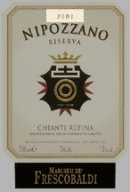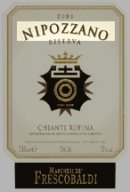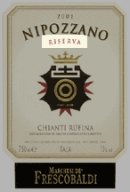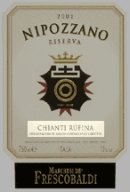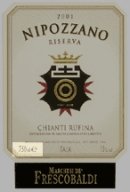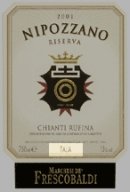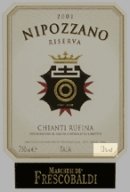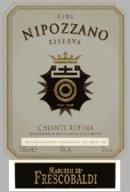The most important thing to remember when reading an Italian wine label is to not panic. Most labels are getting easier to read but there are still a lot out there that are totally and completely confusing. But rest assured – there are a few things you can use to navigate through the madness! The good news is that most Italian wine labels have a rectangular shape. After that, the rest is literally each to his own.
Below is a very fundamental outline of what each part of the front wine label provides – from the top down?o to get you on your way. We have used the 2001 Marchesi de?Frescobaldi Nipozzano Riserva label as a diagram template to explain this better. Each letter corresponds to a different part of the label with a different meaning. Enjoy:
Vintage Date
The vintage date refers to the year the grapes were harvested. In most countries at least 95% of the wine must contain grapes harvested from only that year – however, there are non-vintage (NV) wines which combine juice from multiple vintages. The Italians were once rather lax in requiring that vintage dates be accurate, but now it is much more regulated. It normally will appear on the top center part of the label.
Brand/Name of Wine
In many countries – including Italy – the wine is named for the growing area or appellation where it originated. But most of the time, especially in Tuscany where villas and estates are as far as the eye can see, the wine is named for the estate.
On this label, the wine is called ?ipozzano?/a> because it? from the Frescobaldi’s Nipozzano estate about 19 miles outside Florence in a town called Rufina. The brand name will normally be the most prominent on the label, and by law, the largest. It is normally on the top part of the front label, centered.
Quality of Wine
The quality of the wine is often indirectly conveyed through the legal rank (IGT, DOC, DOCG) which appears on the bottle generally under the appellation or growing region. However, you will see the word “Riserva” used on label for wine that has been matured for a statutory number of years, which Italy regulates. This is another way to convey the quality of the wine to the consumer, and designate it from the competition.
Appellation or Growing Region
The actual growing area or appellation of the wine is generally listed on label because there are so many regions in Italy. This helps to identify the wines characteristics, which are inevitably linked to the individual regional climate. The region normally will pop out at you, and is located someplace central on the bottle. For this label, the wine is a Chainti Rufina – centered at the bottom.
Bottle Volume
The actual size of the bottle is always listed on the label, normally in the lower left hand corner. The volume for your ‘average’ bottle of wine is 750ml (milliliters) but some wines come in large format like 1.5l L (liters), 3 L – or if you’re really going big – 6 L. Sometimes the size is molded into the bottle glass rather than printed on the label, so if the label doesn’t show the bottle size, look along the base of the bottle.
Country of Origin
The country of origin in Italy is Italia?ecause that is where the wine is produced. Depending on some laws though, it may not necessarily be where all the grapes were grown. It is generally on the bottom of the label, centered.
Alcohol Content
The alcohol content is something you should always look for?ven if you’re down for a good time. Most Chianti style wines are not high in alcohol and are meant to be easy to drink, so it’s a non-issue. With desert wines and wines with residual sugar, this is a different story. Trust me – your head will thank me in the morning.
The alcohol percent by volume (% vol) will be on the front label, on the bottom right hand side.
Name of Producer
In the ever expanding world of wine, it is often the name of the producer which will sell the wine. It is by far the most important part of the label, and bottle in general. This is because some producers have a reputation for producing high-quality wines on a consistent yearly basis?nd others – not so much. Although you should be adventuresome, especially in Italy, if you want security in your decision, this is your guiding light.
On most Italian labels the wine will say ‘Imbottigliato da’ followed by the producer’s name – as that means as that means ‘bottled by’ in English. In our case the producer is Marchesi de’ Frescobaldi. In the case of the Nipozzano label, there is also a bottom label separate from the main label which states the producer? name. Since the Frescobaldi? have been making wine for 700 years, the name is extremely important on their product. They like to make it known.
And those are the main parts to the Italian label. Now that you know what to look for – go and enjoy some wine already!

